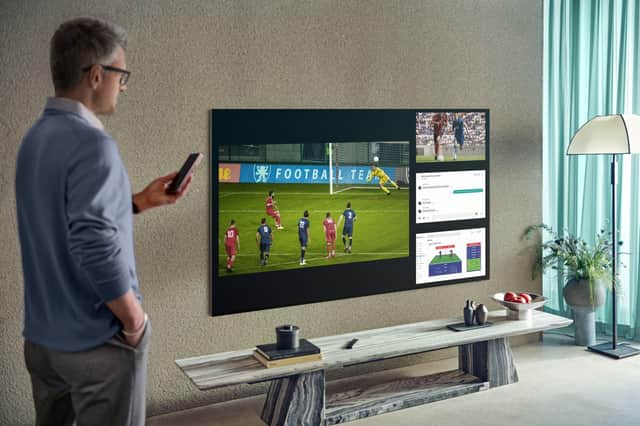Cutting away the cables to reveal TV of the future


The chances are, they didn’t. Because while bolting your television to the chimney breast is easy enough if you’re handy with a Black and Decker, concealing the two platefuls of spaghetti that connect it to the mains, the internet and your set-top box is a different matter.
The professional solution is to get the builders in, chisel out a vertical channel down the wall and then plaster and paint over it once the cables are in place. That’s obviously not something you want to do every time you buy an extra piece of kit.
Advertisement
Hide AdAdvertisement
Hide AdPlastic trunking which runs down the outer surface of the wall is another option, but it seldom enhances your decor. That’s why many of us simply accept trailing wires as a necessary encumbrance, and why they are often removed for photographs.
But signs of a cordless revolution are afoot. Among the exhibitors at CES, the world’s biggest consumer electronics showcase this month, has been a Russian start-up company which says it has developed a TV system that is powered entirely without wires. Even the mains cable is redundant.
The firm, which calls itself Reasonance, demonstrated the prototype of a fully wireless 40-inch TV which gets its required 120 watts of power from a transmitter a few feet away, close to a wall socket. The technology is unclear, but the company says it opens up possibilities for vehicles, industry and other applications far beyond the TV screen.
It will be some time before any of this becomes a reality, but in the meantime Sony’s newest televisions will at least do away with some of the other traditional baggage. The models shown at CES contain a chip powered by artificial intelligence which the firm says can process images in the same manner as the human brain. This means it can adjust the brightness, contrast and even volume to suit your surroundings, without recourse to the remote.
Advertisement
Hide AdAdvertisement
Hide AdSony says it has worked out that the human brain unconsciously focuses on certain points when it sees an object, having scanned the whole image and analysed a range of elements at once. This is something it says its new processor can also do, to create scenes which look more lifelike. The chip will appear in the new Bravia XR range of TVs, which will be in the shops this year.
Its chief rival, Samsung, which is also reported to be working on a wireless system of its own, has used CES to demonstrate a solar-powered TV zapper which can be charged by normal indoor lighting, removing the need for replaceable batteries. The remote itself is made from reusable plastic bottles.
Whichever brand you choose for your next set, it is increasingly likely that it will incorporate the streaming functionality of a Roku box. Roku’s standalone units are the market leaders in adding smart apps to “dumb” TV sets and the same technology is now being licenced to television manufacturers, to save them the trouble of developing their own. This is good news, because Roku’s apps are often faster, smarter and more up-to-date than those on cheap TVs, and they are far more likely to be updated when new services come along.
Roku has also launched a range of wireless products at CES – not TV sets but soundbars which work from the same remote as the Roku apps and greatly enhance the audio from the built-in TV speakers. This is still some way from total wirelessness, but it’s another step towards the televisions of the future. And for this development at least, the future is now.
Advertisement
Hide AdAdvertisement
Hide AdSupport The Yorkshire Post and become a subscriber today. Your subscription will help us to continue to bring quality news to the people of Yorkshire. In return, you’ll see fewer ads on site, get free access to our app and receive exclusive members-only offers. Click here to subscribe.
Comment Guidelines
National World encourages reader discussion on our stories. User feedback, insights and back-and-forth exchanges add a rich layer of context to reporting. Please review our Community Guidelines before commenting.